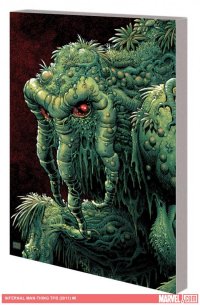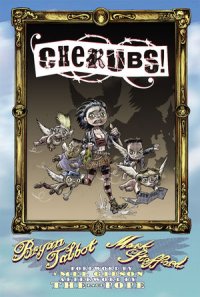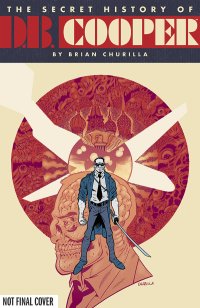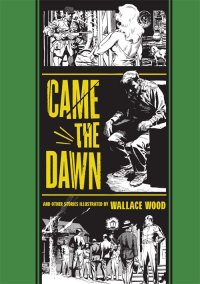|
Five More Reviews in Search of a Column
After three months of no new reviews, things have piled up a bit here at
Nexus Graphica Texas. In an attempt to catch up, there's nothing but reviews this month.

The Infernal Man-Thing, written by Steve Gerber, Gerry Conway, and Roy Thomas, art
by John Buscema, Klaus Janson, Kevin Nowlan, and Gray Morrow (Marvel)
Soon after the Man-Thing's initial 1971 appearance, writer Steve Gerber assumed the role as
the muck monster's primary chronicler, producing a spate of often goofy yet engaging stories centered
around the empathic swamp creature with no personality of its own. In the late 80s after years of
litigation surrounding his seminal creation Howard the Duck, Gerber returned to Marvel and began
working on a graphic novel-length sequel to his story
from Man-Thing #12 (December 1974) "Song-Cry...of the Living Dead Man!" The talented Kevin
Nowlan, working at a glacial pace, could only manage to produce only 1-2 gorgeous painted pages a month. Since
he needed to eat, he accepted other, quicker assignments, further slowing his output. Years after Gerber's
death, the finished story "The Screenplay of the Living Dead Man!" finally appeared in late 2012 as a three
issue mini-series. The Infernal Man-Thing collects that tale along with "Song-Cry" and the very first
Man-Thing appearance from Savage Tales #1 (May 1971), written by Gerry Conway and Roy Thomas
with art by Gray Morrow. As with many of Gerber's tales, both "Song-Cry" and "Screenplay" involve troubled
individuals and social gravitas. The apparently mad writer Brian Lazarus, who produces his craft from within
an abandoned insane asylum, creates demons that have a life of their own. In the sequel set many years later,
Lazarus continues his struggles with his own terrors and his own humanity. Gerber seemingly taps into his own
internal conflicts regarding money and creativity. Nowlan's magnificent illustrations elevate Gerber's often
profound words into an excellent summation of the often troubled writer's career.

Cherubs, script & layouts by Bryan Talbot, art by Mark Stafford (Dark Horse)
Reminiscent of works by Neil Gaiman and Terry Pratchett, Cherubs tromps through some well-trodden turf
in an often hilarious and profound manner. Accused of Heaven's first homicide, five churlish cherubim flee to
New York in pursuit of the real criminal, the renegade archangel Abbadon. Befriended by exotic-dancer Mary and
pursued by unstoppable Seraphim terminators, the Cherubs alone stand against the impending Apocalypse. The
acclaimed Talbot (One Bad Rat, Alice in Sunderland) and cartoonist Stafford skewer a wide range of
supernatural-inspired pop culture icons from Buffy to Scooby-Doo by way of Harry Potter, not to mention the
abundant hypocrisies inherent within Christianity. Similar to the dwarfs of Disney fame, the five unique,
diminutive protagonists often bicker and play among themselves, trading barbs and banter throughout. Stafford's
underground-inspired art lends the proper touch of chaos and levity to the proceedings. While at times
missing the mark and perhaps a tad too long, the excellent Cherubs provides an enlightening,
intelligent, and humorous entertainment.
|

Punk Rock Jesus by Sean Murphy (Vertigo)
In the near future, a clone of Jesus stars in the reality
show J2. After an American Idol-style determination
process, the young virgin Gwen is implanted with the fetus, grown from genetic material supposedly cobbled
together from the fabled Shroud of Turin, and gives birth to the childhood on live TV. Troubled, former
IRA operative Thomas McKae protects the newborn and his mother from various attacks, primarily spearheaded
by religious fanatics. As the conflicted Chris, the name chosen by Gwen for her child, ages he grapples
with his televised reality. The teen "messiah" eventually joins a punk rock band in an attempt to construct
his own destiny. Murphy's scratchy, Steadman-influenced art and Thompson-infused script further enhance
the alternative and edgy subject and like the best of punk music, elevates the seeming rough edges into a
better understanding of the world around us. Blasphemous, irreverent and full of violent imagery, Murphy's
brilliant, heretical Punk Rock Jesus expertly examines the
role of religion in our technological-driven 21st century society.

The Secret History of D.B. Cooper by Brian Churilla (Oni)
After parachuting from a Boeing 747 with $200,000 in 1971, the never-caught D.B. Cooper entered into the
late 20th century American mythology, the impetus for numerous stories including Churilla's surreal
comic The Secret History of D.B. Cooper. In a conspiracy theorist twisted dream of reality, Cooper with
the aid of a talking one-eared teddy bear wages a psychic war against the Soviet enemies of the United
States. Along aside his governrment assigned mission, Cooper hunts for his missing daughter, whom he believes
resides in a mysterious dimension known as the Glut. Meanwhile, enemy agents and even supposed allies attempt to
destroy the troubled Cooper. Churilla further enhances the uniqueness of his tale by relying on a non-linear framework
and art that ranges from cartoony to terrifying. The Secret History of D.B. Cooper, at times creepy and
disturbing but always intriguing, delivers a magnificent and original revisionist history.
|

Came the Dawn and Other Stories, written by Gardner Fox
and Al Feldstein, art by Wallace Wood with Harry Harrison (Fantagraphics)
Beginning in the late 40s through the mid-50s, Wallace "Wally" Wood created memorable stories for the legendary
EC stable of crime, horror, and science fiction comics. Came the Dawn and Other Stories collects all 26
of Woods horror and crime tales from that period. The initial stories, usually with the aide of artistic partner
Harry Harrison (the same one who later created The Stainless Steel Rat) and written by Gardner Fox, offered
fairly run of the mill horror riffs on werewolves, ghosts, and the like. The relatively crude art pales in comparison
to Wood's later brilliance but the occasional extraordinary image or panel crops up. The first story to offer a
glimpse of the future EC and Wood tales, the Al Feldstein-scripted "Death's Double-Cross" delivers an excellent
romantic thrill that effectively showcases Wood's talents. The creepy "Judy, You're Not Yourself" ushered in a
sea change in the quality of stories. The tale effectively shatters the illusions of the supposed idyllic
suburban life in a story that could only be described as an EC-type tale. The further stories tackle
controversial topics such as racism, anti-semitism, police brutality, and sexual morality, all subjects that
were not discussed openly in the uptight, restrictive morality of 50s polite society. Beautifully crafted,
as typical for a Fantagraphics book, Came the Dawn and Other Stories showcases the creative evolution of
one of the true masters of the form. Further rounding out this excellent collection are an introductory essay
examining each story, creator bios, and a short history of EC Comics.
|
Copyright © 2013 Rick Klaw
Professional reviewer, geek maven, and optimistic curmudgeon, Rick Klaw has supplied
countless reviews, essays, and fiction for a variety of publications including
The Austin Chronicle, The San Antonio Current,
The Greenwood Encyclopedia of Science Fiction and Fantasy,
Moving Pictures, RevolutionSF,
Conversations With Texas Writers, Electric Velocipede, Cross Plains Universe,
Steampunk, and The Steampunk Bible.
Coming in March 2013 from Tachyon, he is editing The Apes of Wrath, a survey of apes in literature
with contributions from Edgar Allan Poe, Edgar Rice Burroughs, Franz Kafka, Gustave Flaubert,
Joe R. Lansdale, Pat Murphy, Leigh Kennedy, James P. Blaylock, Clark Ashton Smith, Karen Joy Fowler,
Philip José Farmer, Robert E. Howard and others.
Klaw can often be found pontificating on Twitter
and over at The Geek Curmudgeon.
|

